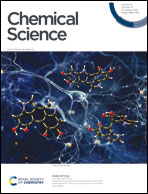Adaptive coordination assemblies based on a flexible tetraazacyclododecane ligand for promoting carbon dioxide fixation†
Abstract
Coordination hosts based on flexible ligands have received increasing attention due to their inherent adaptive cavities that often show induced-fit guest binding and catalysis like enzymes. Herein, we report the controlled self-assembly of a series of homo/heterometallic coordination hosts (Me4enPd)2n(ML)n [n = 2/3; M = Zn(II)/Co(II)/Ni(II)/Cu(II)/Pd(II)/Ag(I); Me4en: N,N,N′,N′-tetramethylethylenediamine] with different shapes (tube/cage) from a flexible tetraazacyclododecane-based pyridinyl ligand (L) and cis-blocking Me4enPd(II) units. While the Ag(I)-metalated ligand (AgL) gave rise to the formation of a (Me4enPd)4(ML)2-type cage, all other M(II) ions led to isostructural (Me4enPd)6(ML)3-type tubular complexes. Structural transformations between cages and tubes could be realized through transmetalation of the ligand. The buffering effect on the ML panels endows the coordination tubes with remarkable acid–base resistance, which makes the (Me4enPd)6(ZnL)3 host an effective catalyst for the CO2 to CO32− conversion. Control experiments suggested that the integration of multiple active Zn(II) sites on the tubular host and the perfect geometry match between CO32− and the cavity synergistically promoted such a conversion. Our results provide an important strategy for the design of adaptive coordination hosts to achieve efficient carbon fixation.



 Please wait while we load your content...
Please wait while we load your content...